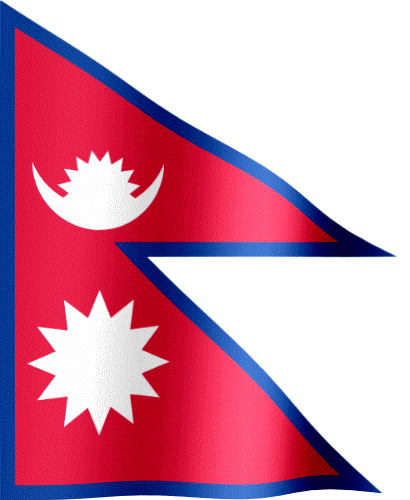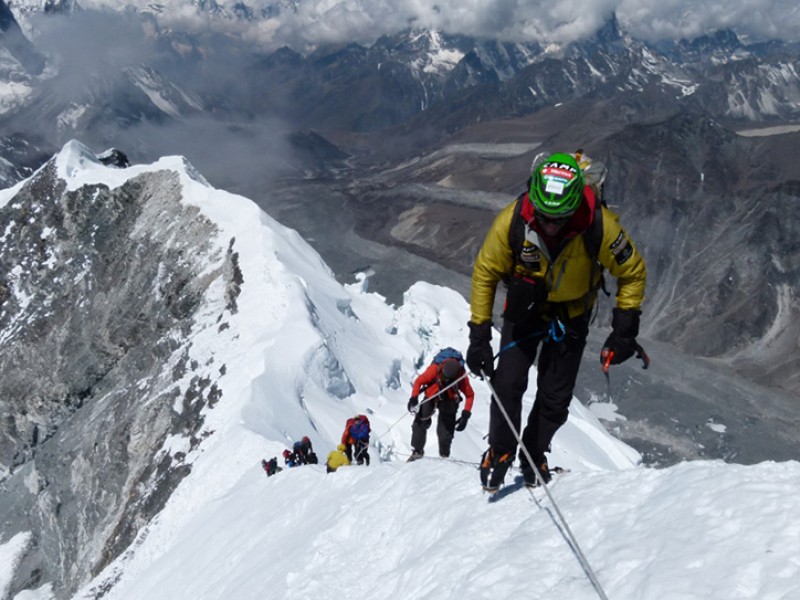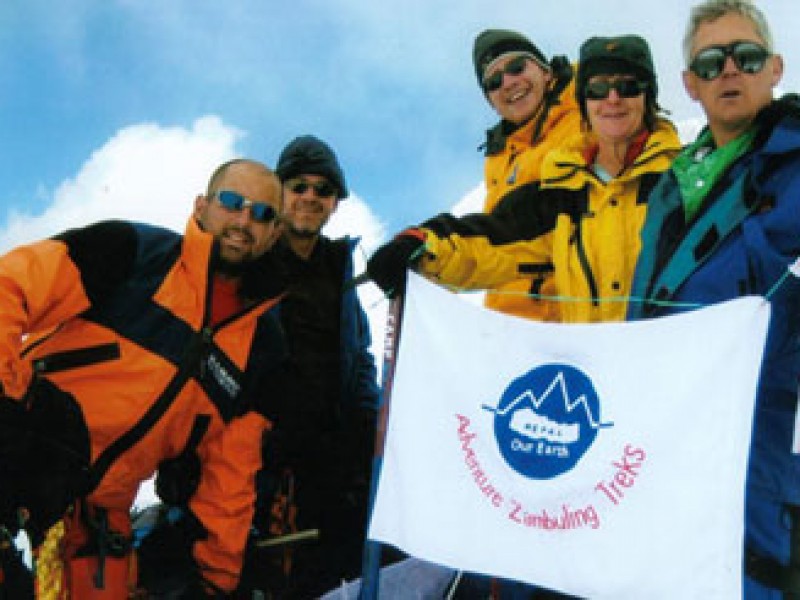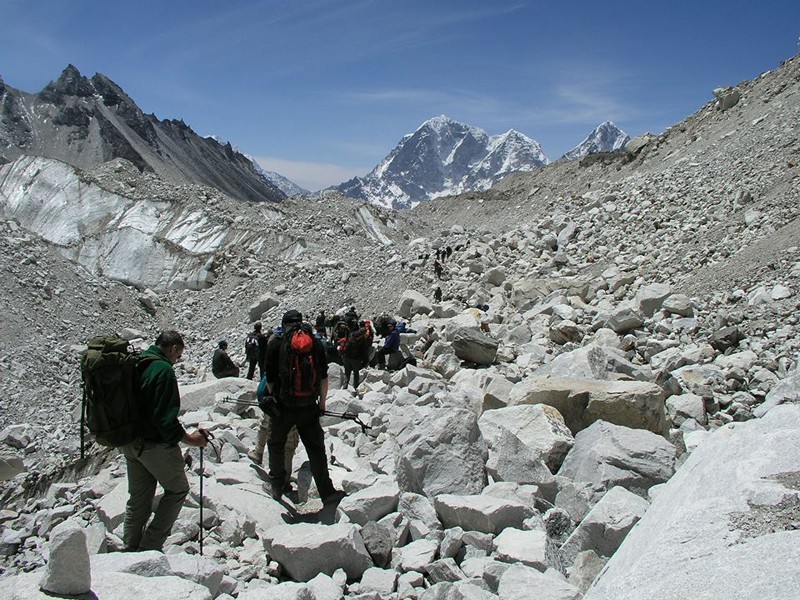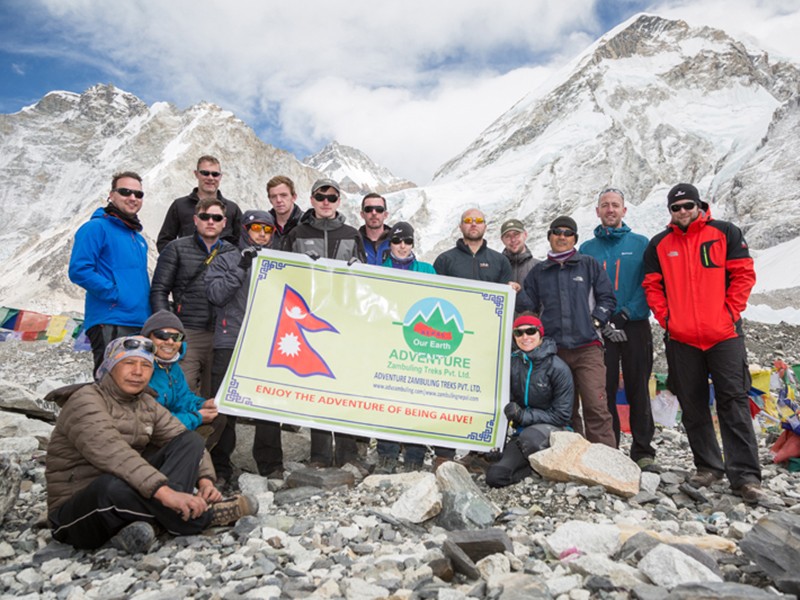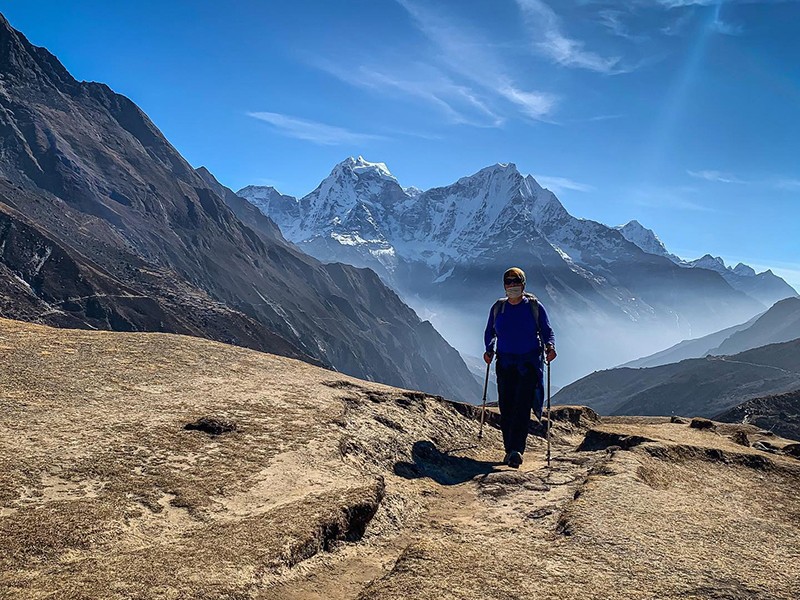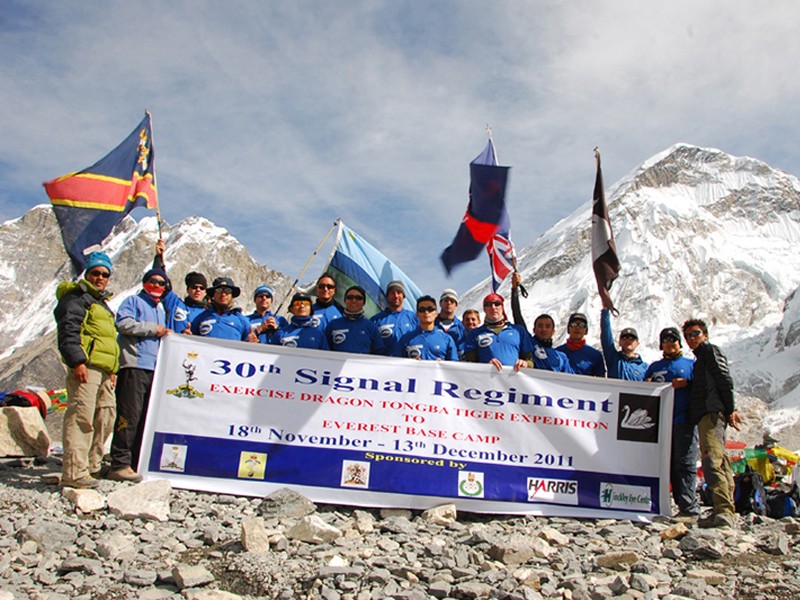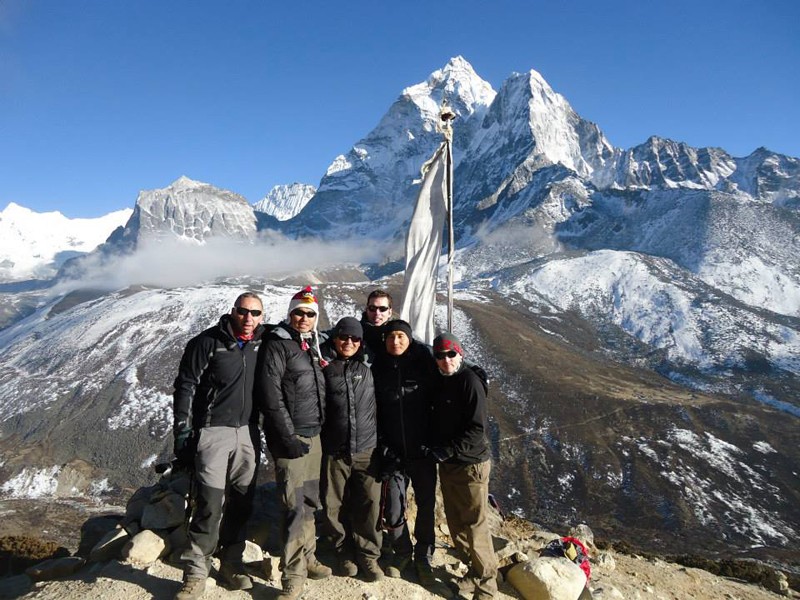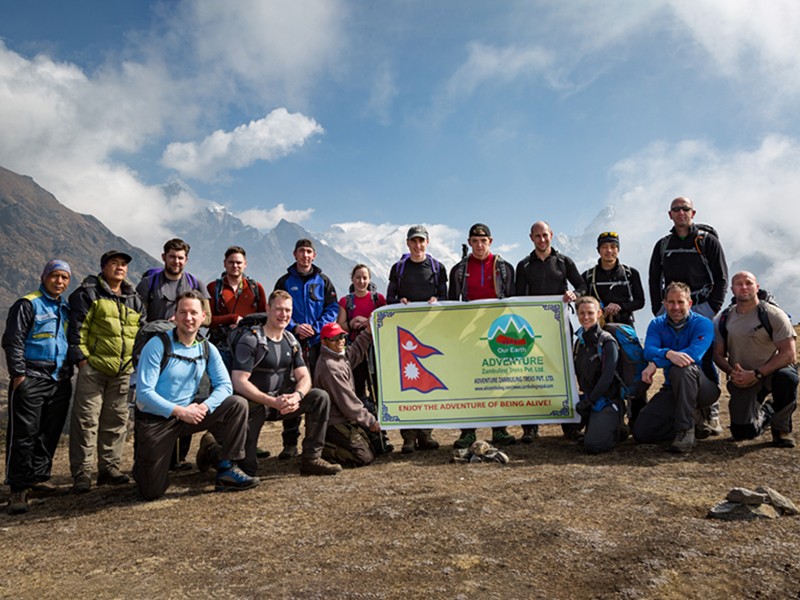Reference Code: SKCCNP
Trip Start: Kathmandu
Trek Start: Lukla
Trek Days: 25 Days
Maximum Altitude: 6189m.
Age: 20 years to 60 years
Season: Autumn
Accommodation: Lodge and Camp
Service: Full board
Destination: Nepal
Trip End: Kathmandu
Trek End: Lukla
Trip Durations: 29 Days
Peak Grade: Modurate
Physical Rating: Strenuous
Group Size: 4-16
Theme: Walking, peak climbing and observation
Meals: Standard
Mount Everest (Nepali:Sagarmatha , Tibetan:Chomolungma, Chinese:Zhumulangma Peak, pinyin: Zhumulangma Feng), Chajamlangma (Limbu), or Mount Chomolungma) is the world's highest mountain above sea level at 8,848 metres (29,029 ft). It is located in the Himalayas in Asia. A direct approach to the foot of the world's highest mountain - Mount Everest.
Strenusous Khumbu Climb Challenge trek is specially designed to those who wants extreme thrills with peak climbing. This trip includes 3 different trekking peaks and 3 high passes including Mount Everest Base camp and Gokyo Lake. This is one of the hardest trek and normally done with lodge mode except camping during climbing period. Only few people are able to complete this trip as it requires high physical fitness.
Island Peak (Imjatse) is the most popular trekking peak in Nepal. This mountain is seen like an island in a sea of ice from Dingboche. The summit is interesting attractive with a hightly glaciated west face rising from the Lhotse Glacier. The mountain itself is the extension of the south Ridge of Lhotse Shar separated by a small col. The ridge raising to the south from this point leads to the summit of Island Peak. The extension of this ridge descending southwest is the part of the normal route of ascent and leads to the south summit. Island Peak not only provides pleasant climbing but also provides some of the most spectacular scenery of Himalayas in the Khumbu region. This is one of the steep climbing peak and windy at the top with quickly changing climate. In clear day we can view the gaint mountains like Nuptse, Lhotse, Lhotse Middle Peak and Lhotse Shar make a semi circle in the north, the views of Makalu in the East and Baruntse and Amamdalam in the south add more charm for climbing Island peak
Pokalde Peak (or Dolma Ri) (5806m.) is a mountain peak of Nepal situated 12 km southwest of Mount Everest. Pokalde Peak is one of the shortest and easiest trekking peaks in the Everest Region. The majority of the 650m climb from base camp requires little more than walking with short sections of scrambling up rock.
During the trekking seasons this rocky peak is scarcely covered by snow. Despite its lack of any great technical difficulty, it offers trekkers the prospect of reaching 5,800m in elevation and superb views from the summit, particularly to the South East, North West and West. Other prominent mountains visible from the summit include Makalu, Ama Dablam and Pumori. Because of its relatively low difficulty and impressive summit vista's for this altitude, Pokalde is a popular commercial tourist peak in Nepal for those wishing to climb a Himalayan peak without needing to use ice axes and crampons.
The first ascent of Pokalde Peak was made in April 1953 via the ridge adjoining the Pokalde summit with the Kongma La high pass (5535m). This ridge continues from Kongma La to the slightly higher Mehra Peak (Kongma Tse) at 5820m and beyond. Hence the prominence of Pokalde Peak is modest at 271m (889 feet). Most ascents of Pokalde Peak nowadays are made by skirting the opposite Makalu side of the mountain.
Lobuche East Peak (6119M) is the hardest of the trekking peaks (fee: $350 for four climbers) that commercial groups attempt. In the Everest region(Khumbu) only Kwangde and Kusum Kangguru are more difficult. The main peak of Lobuche, however is to the NW of Lobuche East and is not included in the trekking peak permit. Therefore, a legal climb to Lobuche West (Main) requires an expedition-peak-permit and is considerable more expensive than Lobuche East. Now follows a description of Lobuche East (20075ft, 6119m 27° 57' 34.2? N, 86° 47' 23.8? E). Very few climbers who attempt this peak reach the real summit, but many attain the worth-while false summit. Good conditions and a dawn or pre-dawn start is recommended. The average angle for the rocky slabs above the lake (high camp) at about 16,500' to the start of the snow ridge at around 18,600' average 45 to 50 degrees and the route is marked with cairns. This is nice for alpine starts. These rock slabs could be tricky with snow on the rock and there are a couple of moves as you approach the SW ridge that parties may want to be roped up to surmount. It is better to avoid the south west face unless you are looking for more of a challenge. Most climbers who take the SW ridge approach stop at the top of the ridge and consider this to be the false summit of Lobuche East. To reach the true summit of Lobuche East, which is a continuation on the knife-edged ridge heading north west, a rope is recommended due to the exposure. A fall here would be disastrous. There is a slight descent from the false summit along the NW ridge and then a steep climb to the highest point on the long summit ridge. This is a couple of rope lengths at most. From the true East summit, you will see more knife edge ridge leading NW to a massive notch that separates Lobuche East from Lobuche West, which is higher. The true summit proved to be, at first, an unatainable goal, but rocky outliners of Lobuche East were first climbed by the Swiss in 1952. Subsequent attempts fell short of the summit, finally climbed in 1984. Lobuche West was first climbed in 1955, by the South shoulder, which was also the first attempt. Since then the mountain has been scaled only a few times, also by the East-Face.
Adventure Zambuling Treks has sucessfully completed this trip with 100% safety number of times previously.
Inclusion
Lodge/camping basis
All ground transportation as per itinerary
4 night hotel accommodation in Kathmandu with B/B plan.
Full day sightseeing in Kathmandu valley with English Speaking Cultural guide
Both way domestic Air fare (KTM-LUK-KTM) with airport tax
Cargo charges
TIMs (Trekking Information Management system) card
Everest National Park Entry fee
Peak climbing permit
Food for the members on camping basis/ Lodge basis
Lodge charges
Medical supplies(First aid Kit will be available)
All camping equipment and camping charges during climbing period
All required group climbing equipments( like fixed ropes, man rope, ice bar, ice screw.....)
All required Nepalese staffs including climbing support sherpa
Climbing support Sherpa equipments
All Nepalese staffs insurance as per Nepalese government rules
Company service charge, VAT and government taxes etc.
Exclusion
International flight with airport tax.
Nepalese Entry Visa fee
Food during stay in Kathmandu
All personal equipment and personal expenses
All personal climbing gears
Photography Charges, Monument charges and Monument entry fees
Personal Medical and travel insurance(must cover helicopter rescue evacuation cost)
Personal Medicine
Telephone and internet charges
Laundry charges
Alcoholic beverage, bottled drinks and cold drinks during the trip
Rescue evacuation charges if required
Staffs and porters Tips...
Equipment List
This trekking equipment list has been prepared by Adventure Zambuling Treks (P) Ltd.
Climbing equipment:
» Climbing harness;
» One 3 metre/10 foot sling and three 2 metre/6 foot slings.
» Figure 8/Abseil belay device;
» 1 large mitten sized ascender (most members use the large petzl) and arm length leash;
» 2 locking carabiners, (1 large and 1 small)
» 4 regular carabiners;
» Good quality Ice axe with leash;
» Crampons - must fit boots perfectly. Steel crampons with anti-balling (anti-bot) plates are the best;
» Optional; Adjustable trekking poles;
Upper Body:
» 2 cotton t-shirts;
» 1 polypropylene t-shirt;
» 1 long sleeve polypropylene shirts, lightweight;
» 1 polar fleece pullovers, medium weight;
» 1 polar fleece jacket.
» Gore-Tex jacket with hood, waterproof and breathable;
» Lightweight down jacket for those chilly days in camp;
Hands:
» 1 pr. lightweight poly-liner gloves. These will be worn when tying knots, but not inside your mitts;
» 1 pair mittens, consists of 1 Gore-tex over mitt matched with the very warm polar fleece mitt liner (For more about high altitude mitts.
Head:
» Warm hat wool or synthetic that covers your ears;
» Balaclava;
» Face mask;
» Ballcap or brimmed suncap;
» Glacier sunglasses with side shields (you can purchase these inexpensively in Kathmandu,
» 1 pair ski goggles (Optional) with light and dark lens;
» Headlamp with extra batteries and bulbs;
» Bandana or head scarf, also useful for dusty conditions.
Lower Body:
» Cotton underwear briefs;
» 1 pair walking shorts;
» 1 pair walking trousers for trekking and around camp;
» 1 pair lightweight thermal bottoms;
» 1 pair medium or expedition weight thermal bottoms;
» 1 pair polar fleece trousers;
» 1 pair Gore-Tex trousers, salopettes, or bibs. Waterproof/breathable with full side zips;
Your clothing should be kept dry using waterproof stuff sacks, bin-liners, or large plastic bags.
Feet:
» 1 pair Double Plastic boots (Koflach);
Modern single waterproof-leather climbing boots with special insulation for cold weather/winter climbing on 4000 metre/13,000 foot high peaks are OK, as long as they will fit comfortably with two thick pair of socks and a vapour barrier liner and the boot will fit the crampon perfectly.
» 1 pair sturdy leather walking boots with good ankle support (we mean leather trekking, not climbing boots) for the trek;
» 1 pair trainers, running shoes and/or sandals for Kathmandu and in camp;
» 1 pair down booties (optional);
» 2 pair med-heavy poly or wool socks;
» 2- pair of liner socks. Polypropylene or wool;
» Vapour barrier liner socks or plastic bread-bags;
» 2 pair lightweight trekking socks, poly or wool;
» Cotton socks for in town.
Sleeping:
» 1 good quality sleeping bag (good to -30 degrees C)
» At least 1 closed cell foam kari-mats. We do not recommend inflatable mats, as we have never seen one not puncture. You can buy these non inflatable mats very inexpensively in Kathmandu. Why carry foam mats around the world, when you can purchase them inexpensively in Kathmandu?
Your sleeping bags should be kept dry using waterproof stuff sacks, bin-liners, or large plastic bags.
Rucksack and Travel Bags:
» 1 medium rucksack (50-70 litres / 3000-4500 cubic inches, can be used for airplane carry);
» 1 or 2 large (120 L / 7500 cubic inch) duffle kit bags for clothing and equipment. Must be durable for use on pack animals or porters;
» Small padlocks for duffel kit bags.
Personal Hygiene:
» female or male hygiene supplies;
» 2 tubes lip sun cream, 1 large tube skin sun cream (min.factor 15);
» anti-mosquito cream;
» 1 toothpaste/brush;
» 1 bar soap or hand sanitizer gel/1 small towel;
» hand wipes.
Medical:
Medications are inexpensive and readily available in Kathmandu with no Doctor`s prescription:
» small personal first-aid kit. (Simple and Light) Aspirin, first-aid tape, plasters (band-aids), personal medications, etc. The leaders will have extensive first-aid kits, so leave anything extra behind. Please let your leader know about any medical issues before the climb;
» 1 skin blister repair kit;
» 1 small bottle anti-diarrhea pills;
» 1 small bottle anti-headache pills;
» 1 small bottle cough and/or cold medicine;
» 1 small bottle stomach antibiotic: Ciprofloxacin, etc.;
» 1 small bottle anti-altitude sickness pills: Diamox, Acetylzolamide.
» Do not bring sleeping pills. They are a respiratory depressant;
» 1 small bottle of water purification tablets or water filter;
» 1 set earplugs;
» Extra prescription glasses, contact lens supplies. Contact lens wearers, please bring glasses in case of emergency. A new pair could be quickly made in Kathmandu, Lhasa, or Kashgar for just $20. Please order upon arrival if you are interested.
Personal Food:
On the mountain we supply plenty of food for you to cook 3 hot meals each day. This food will consist of soup, local cheese & sausage, biscuits, dried noodles, potatoes, rice, porridge, butter, dried and tinned vegetables, fruit, meats, and fish, tea with milk and sugar, powdered juice drink, and drinking chocolate. Our sherpas/local porter will be carrying this food to the higher camps.
» We ask each member to bring their own imported daily snack and energy foods. We do not provide cold “snack” food such as chocolate or "energy-bars". We ask that you bring or buy your own "snack" or daily cold energy food, 2-3 kilos/4-6 pounds is a good amount (for the trek and Island Peak combined). A growing variety of imported foods such as European and American cheeses, chocolates, biscuits, cookies, nuts, and locally made power-bars are now available in Kathmandu, at realistic prices. However, imported power bars, GU, re-hydration drinks, dehydrated food, "freeze-dried meals", imported cheese and sausage are not available. If you want these items, you must bring them from your home country. Many of our members, especially Britons, Europeans, and Australians with tiny baggage allowances, now purchase their daily snacks in Kathmandu. Our schedule in Kathmandu allows plenty of time for shopping.
Practical:
» 1 small roll of repair tape, 1 sewing repair kit;
» 1 cigarette lighter, 1 small box matches;
» 1 compass or GPS;
» Recent good quality map of visiting area.
» 1 battery powered alarm clock/watch;
» 1 camera and film, or digital camera with extra cards and extra batteries;
» nylon stuff sacks For food and gear storage, large Ziplocs are useful also;
» 3 Water bottles (1 litre) wide-mouth Nalgene (1 is a pee bottle);
» 1 plastic cup and spoon;
» 1 small folding knife;
» binoculars (optional);
» 4 large, waterproof, disposable rubbish sacks;
» passport, 2 extra passport photos, flight ticket, flight itinerary;
» separate photocopies of passport and relevant visa pages, proof of insurance;
» dollars, pounds or euros cash for purchasing Nepalese visa at Kathmandu airport, Tibet visa, for paying for restaurants and hotels, for gratuities, snacks, and to purchase your own drinks and gifts;
» credit cards, Bank/ATM/Cash machine cards for use for withdrawing funds from cash machines (bring a photocopy of your cards), traveler's checks, etc.;
» 1 bathing suit/swimming costume (you never know);
» basecamp entertainment. It is good to bring additional items which you have found to be useful on previous expeditions. For example: paperback books, playing cards, ipod mp3 player, short-wave radio, game boys, musical instruments, ear plugs, lots of batteries, etc.;
» travel clothes for basecamp and in town;
This Peak Climbing equipment list has been prepared by Adventure Zambuling Treks (P) Ltd.
Please submit any equipment questions or concerns to: info@advzambuling.com


